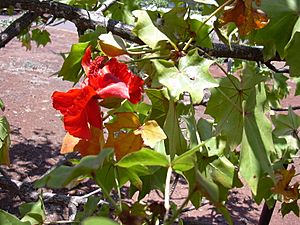Kokia (plant) facts for kids
Quick facts for kids Kokia (plant) |
|
|---|---|
 |
|
| Kokia cookei | |
| Scientific classification |
|
| Kingdom: | Plantae |
| Clade: | Tracheophytes |
| Clade: | Angiosperms |
| Clade: | Eudicots |
| Clade: | Rosids |
| Order: | Malvales |
| Family: | Malvaceae |
| Subfamily: | Malvoideae |
| Tribe: | Gossypieae |
| Genus: | Kokia Lewton |
| Species | |
|
See text |
|
Kokia, also known as treecotton, is a group of flowering plants. These plants belong to the mallow family, called Malvaceae.
All species of Kokia are found only in the Hawaiian Islands. This means they are endemic to Hawaii. You won't find them growing naturally anywhere else in the world!
Contents
What is Kokia?
Kokia plants are special trees or shrubs. They are known for their beautiful flowers. These flowers often have a unique shape and color. They are an important part of Hawaii's natural environment.
Where Kokia Lives
Kokia plants grow in different parts of the Hawaiian Islands. Each type of Kokia might prefer certain conditions. They often grow in forests or drier areas. Their survival depends on their specific Hawaiian homes.
Types of Kokia Plants
There are a few different species, or types, of Kokia. Each one is unique and found on specific islands. Sadly, some of these species are very rare today.
- Kokia cookei - This type is from the island of Molokaʻi. It is also called Molokaʻi treecotton.
- Kokia drynarioides - You can find this species on the Island of Hawaiʻi. It is known as Hawaiian treecotton.
- Kokia kauaiensis - This one grows on the island of Kauaʻi. People sometimes call it Kauaʻi Kokiʻo.
- Kokia lanceolata - This species is another unique Kokia plant.
Why Kokia is Important
Kokia plants are a vital part of Hawaii's ecosystem. They provide food and shelter for local wildlife. They also help keep the soil healthy. Protecting these plants helps protect the whole Hawaiian environment.
Protecting Kokia
Many Kokia species are endangered. This means they are at risk of disappearing forever. Scientists and conservationists are working hard to protect them. They try to grow new plants and save their natural habitats. This helps ensure these special trees continue to thrive.
See also
 In Spanish: Kokia para niños
In Spanish: Kokia para niños

